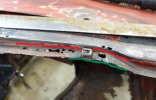Hi all,
Long time, no update. But, I've continued to slowly get work done. I've got both floors and rockers replaced:
Along with the battery tray, bottoms of both rear wheel arches and various other patches. Once that stuff was secure, I braced the tub and removed it from the frame:
I've started stripping the frame and there aren't any real surprises, but I do have a frame patch to do because the water had sat on it where the floor had rusted away. The top is full of pits and they turn the corner and extend about 1/3 of the way down the vertical. Thankfully, it's not in a difficult spot, but it is the frame. I took a wire wheel to it and there are several areas where the pitting is through. Here's a pic:

The frame is a box section, with the welded seam at the top (in the pic). I think it's about 14-ga, but I need to verify that. My question is how would you recommend I approach the repair? Multiple (maybe two) welded together (weld both sides of union)? Try to manufacture it as a single piece (I don't have heavy-duty metal forming tools, but I might be able to come up with something). The curves of the unwelded corners of the box are pretty rounded so I'd like to do one piece, just not sure I can fabricate it, especially with the curve that happens as the frame moves to the right (in the pic). Two pieces will probably be a hard edge unless I try to round it, but that may be more trouble than it's worth.
Modified pic of my initial thought:
Any advice / ideas are greatly appreciated. There are no frame patch panels for this area available commercially and I don't have access to a donor frame. The pic isn't clear, but any patch should fit comfortably between that front outrigger and the cross-member that attaches on the left side so I'm not concerned with interference from existing attachments. Thanks!


